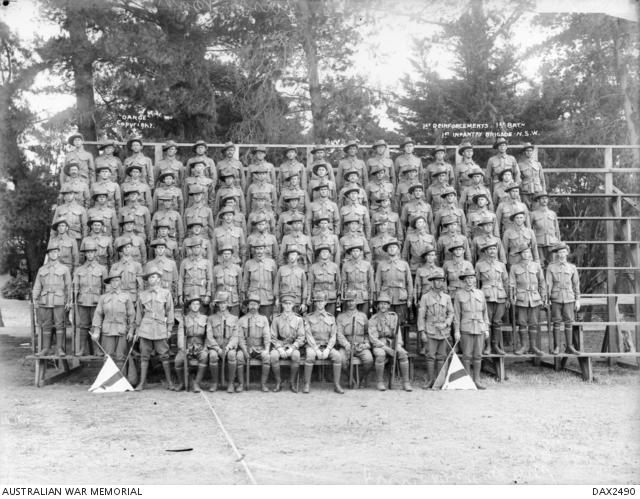Researching a Unit
This guide will help you to find information about a unit (such as a battalion, regiment, squadron or ship) which participated in any of the conflicts in which Australian forces were involved.
If you are researching an individual's war experience, you will need to know the name of the unit/s in which the individual served and the periods during which he or she served in each unit. Individuals often served in more than one unit.

1st Reinforcements, 1st Australian Infantry Battalion, December 1914. AWM DAX2490
What is a unit?
A unit is a military force grouping such as an army regiment or battalion, an air force squadron, a naval vessel or shore establishment. For more information on units, see our guide to Understanding Military Structure.
Where do I start?
Some army and air force units are profiled on the Memorial's website. Profiles include:
- short history of the unit
- details of its casualties, decorations, battle honours, commanding officers
- for technical units, specifications of its equipment
- access to documents, media and objects the Memorial holds that are related to that unit.
Note not all units have a unit profile.
Where do I look next?
There are several sources which include information on where a unit served and operations in which it was involved.
- Official histories
- detailed, chronological record of all services and theatres of conflict
- provide contextual information about the unit’s involvement in the conflict
- official histories series listed on the Memorial’s website
- First and Second World War histories digitised and available online
- Published unit histories
- provide the history of an individual unit during a specific war, or sometimes throughout its existence
- often contain information related to the unit, such as nominal rolls, rolls of honour, or lists of honours and awards
- Look for published unit histories in the Memorial's Collection search
- Check with your local library for availability
- Manuscript unit histories
- Check the Memorial’s research guides for sources of information for specific conflicts
What primary sources are available?
Official records
Official records refer to records raised by government agencies. They are key primary sources for historical studies.
The official records held at the Memorial include operational and planning records created by the Australian Army, Navy, and Air Force during wartime and the papers of the official historians
Some Official Records digitised and available on the Memorial’s website. Collections not digitised can be viewed in the Research Centre’s Reading Room.
Search the National Archives of Australia database RecordSearch to identify official records series held in the Research Centre.
Key official record series:
- Australian Army war diaries
- Royal Australian Navy Reports of Proceedings
- HMA ships logs (AWM35)
- Royal Australian Air Force Formation and Unit records
Private records
Private records come from many sources. Some come from non-government organisations but most are the personal papers of individuals from all ranks and services of the Australian armed forces. They include privately donated diaries, letters, notebooks, papers, and cards written during wartime, as well as some reminiscences written after the event.
Search the Memorial's website to locate private records collections. Most collections are not digitised and can only be viewed in the Research Centre's Reading Room.
Where else can I find information about units?
- National Archives of Australia, records of the Australian defence forces
- RAAF Museum, Squadron Histories and RAAF Aircraft
- Royal Australian Navy, Ship Histories
- Royal Australian Navy, the Fleet
- National Archives of Australia, Navy crew and ships records – Fact sheet 31